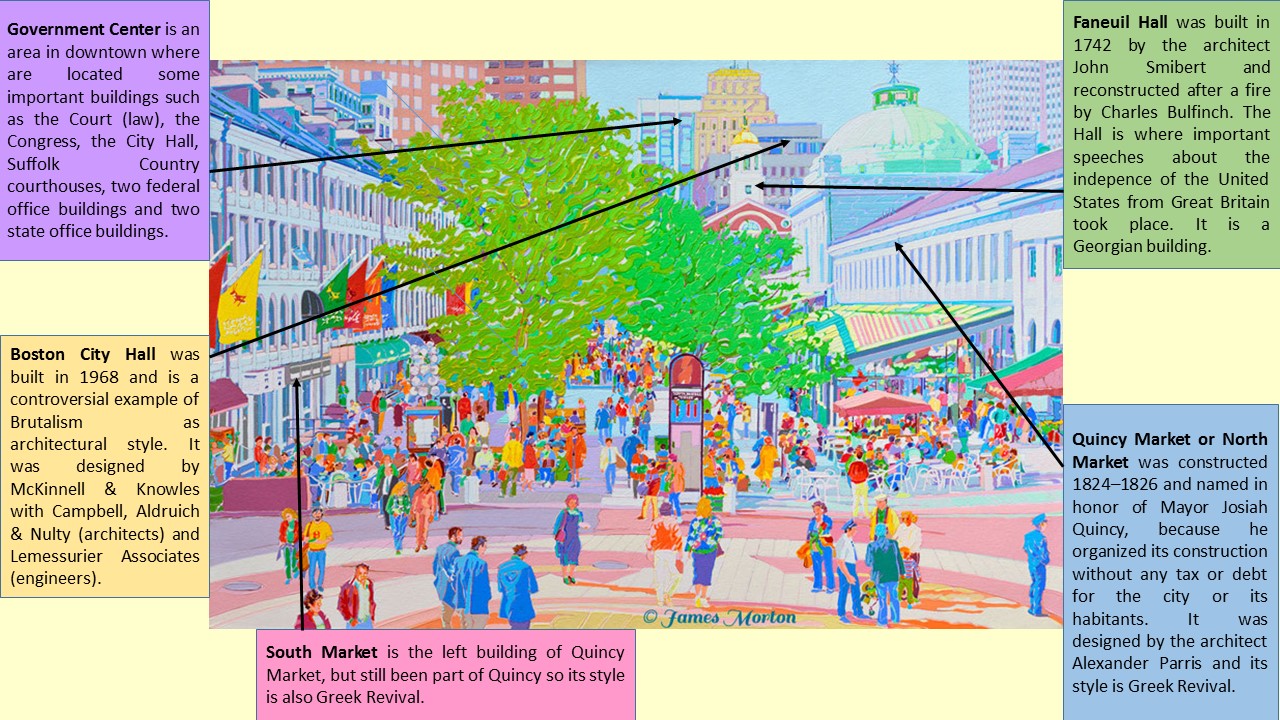BOSTON (James Morton, 2012)
This work of art belongs to a collection of 62 paintings and Fine Art Glicéé (an exact digital printout from an original work) of Boston, Massachusetts. This compilation is named “Bostonscapes” and is divided in four pages, where all are original acrylic paintings. This image represent Quincy Market and is on the third page. It is a recent painting created by James Morton, who owns Morton Arts with Sara Morton since 1997. He started painting in 1965, while he was in university, without anyone’s help because hardly one used acrylics. Nowadays he has a collection of 178 paintings.
Boston, Massachusetts, is considered the main cultural, political and commercial city in New England and has 636.479 habitants. It is located in the north-east coast of the United States. It was founded in September 1630 and since then it has swallowed up hundreds of hectares. It has bridges, train, dock, airport and also the first underground after London’s one. This is not a coincidence, in the other bank of its river, Charles, is located one of the most prestigious universities of the world, Harvard, and the MIT (Massachusetts Institute of Technology).
We can distinguish the contrast between old and historical buildings and skyscrapers and modern offices, which is characteristic from this city. In the image, we can appreciate a wide, straight, pedestrian street, crowded of a big variety of people. That is because Quincy Market is part of a shopping area and also because in Boston coexist lots of different cultures. It also receives thousands of tourist per year, fact that we can deduce from the information posts located in different points of the street.
Regarding the buildings we can see the Quincy Market composed be two constructions, the one of the right is the North Market which has food-stalls and souvenir stands and the one of the left which has restaurants and shops such as Abercombie or GAP. In the foreground is situated the Faneuil Hall, a Georgian building designed by the architect John Smibert. He created it in the style of an English country market, with an open ground floor serving as the market house and an assembly room above. In 1761 the Hall suffered a fire and it was rebuilt by Charles Bulfinch. Behind the Faneuil Hall it is raised the Boston City Hall, with a Brutalist architecture style. It is in Government Center, an area in downtown where are located other important buildings not because of its architecture, but for its roles. Some of them are the Court, the Congress, two Suffolk Country courthouses, two federal office buildings and two state office buildings. The City Hall plaza, where the City Hall is, is used for social events like concerts.
Faneuil Hall is not just a marketplace, it is also a meeting hall where Samuel Adams, James Otis and others did speeches about the independence from Great Britain. It is the place where were discussed the famous Tea Party and the Boston Massacre. In 1773, 8.000 people gathered to protest some matters like the taxes. Between all these people there was a group of radicals, the “Liberty Sons” who trigger the Independence war through the Tea Party. Because of that, every 4th of July it is represented the independence war in the Boston Common, the “lung” of the city with the Boston Public Garden.
María Oñoro Prieto

